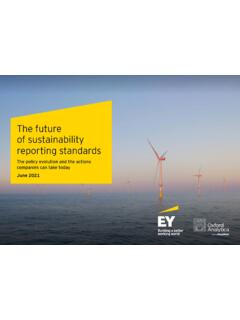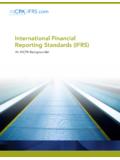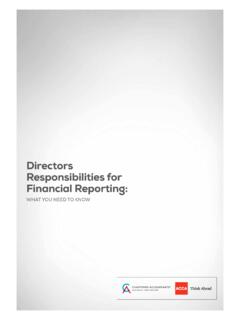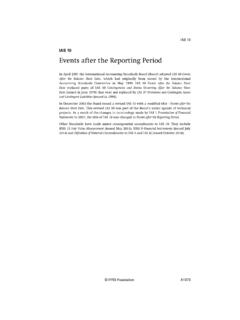Transcription of GLOBAL REPORTING INITIATIVE (GRI) STANDARDS
1 GLOBAL REPORTING INITIATIVE (GRI) STANDARDS1 GLOBAL REPORTING INITIATIVE (GRI) STANDARDSF ebruary 2017 REPORTING on sustainability issues that matter GLOBAL REPORTING INITIATIVE (GRI) STANDARDS1 MAKING THE MOST OF GLOBAL REPORTING INITIATIVE (GRI) STANDARDSAs investors and stakeholders demand increased disclosure of sustainability risks and opportunities, frameworks for non-financial REPORTING have proliferated. Non-financial information may be disclosed in a variety of formats, including standalone sustainability reports or alongside traditional financial information in corporate annual GLOBAL REPORTING INITIATIVE (GRI) is an independent, international organization dedicated to helping businesses and governments report effectively and publicly disclose the impact of their activities on key environmental, social, and governance (ESG) sustainability issues.
2 This is accomplished through GRI s Sustainability REPORTING STANDARDS , a GLOBAL best practice in organizational sustainability REPORTING , launched in late 2016. These STANDARDS are an evolution of the GRI G4 Sustainability REPORTING Guidelines, which were released in 2013, and have since been widely adopted. GRI adopted this modular set of STANDARDS to allow for easier updates to specific topics without requiring the entire set to be republished. This is intended to keep the STANDARDS more relevant over time as GRI announces sections that are undergoing updates. Renaming the GRI REPORTING Guidelines as STANDARDS is also intended to lend further legitimacy and rigor to REPORTING STANDARD FOR SUSTAINABILITY REPORTINGUNIVERSAL STANDARDSTOPIC-SPECIFIC STANDARDS200 Series Economic300 Series Environmental400 Series SocialGRI 201: Economic PerformanceGRI 202: Market PresenceGRI 203: Indirect Economic ImpactsGRI 204: Procurement PracticesGRI 205: Anti-corruption 2016 GRI 206: Anti-competitive BehaviorGRI 301: MaterialsGRI 302: EnergyGRI 303: WaterGRI 304: BiodiversityGRI 305: EmissionsGRI 306: Effluents and WasteGRI 307: Environmental ComplianceGRI 308: Supplier Environmental AssessmentGRI 401.
3 EmploymentGRI 402: Labor/Management RelationsGRI 403: Occupational Health and SafetyGRI 404: Training and EducationGRI 405: Diversity and Equal OpportunityGRI 406: Non-discriminationGRI 407: Freedom of Association and Collective BargainingGRI 408: Child LaborGRI 409: Forced or Compulsory LaborGRI 410: Security Practices GRI 411: Rights of Indigenous PeoplesGRI 412: Human Rights AssessmentGRI 413: Local CommunitiesGRI 414: Supplier Social AssessmentGRI 415: Public PolicyGRI 416: Customer Health and SafetyGRI 417: Marketing and LabelingGRI 418: Customer PrivacyGRI 419: Socioeconomic ComplianceThe GRI STANDARDS begin with three Universal STANDARDS to disclose general information about an organization and their approaches to sustainability management.
4 Further topic-specific STANDARDS outline approaches to disclosing qualitative and quantitative information deemed material for each REPORTING organization. GRI 101 GRI 102 GRI 103 Foundation: The starting point for using the GRI StandardsGeneral Disclosures: Used to report contextual information about the organizationManagement Approach: Used to disclose how the organization manages impacts related to each of their material topics GLOBAL REPORTING INITIATIVE (GRI) STANDARDS2 HOW DO THE GRI STANDARDS COMPARE TO THE GRI G4 GUIDELINES?Concepts and disclosures from the previous G4 Sustainability REPORTING Guidelines have mostly carried over to the new STANDARDS , minimizing disruption for established reporters.
5 No new topics have been added to the new STANDARDS . While they contain all of the main content and disclosures from G4, some disclosures have been removed to minimize duplication and parts of some disclosures have been merged or revised for greater clarity. Key updates include: Aligning language with that used by ISO STANDARDS , giving organizations clearer distinctions between REPORTING requirements ( shall ), recommendations ( should ) and guidance. Revising many disclosure requirements to recommendations , providing organizations with flexibility to report available and material information. Changing the term indicators to disclosures , referring to both qualitative and quantitative disclosures.
6 Defining key concepts in the new STANDARDS more clearly, making them more accessible for organizations looking to adopt GRI for the first time. Requiring more detail on describing the management approach to material topics, including information on policies, commitments, goals and targets, responsibilities, resources, grievance mechanisms and specific actions that the organization uses. Incorporating the Greenhouse Gas (GHG) Protocol s Scope 2 Guidance for REPORTING both market-based and location-based emissions. This update to the GHG Protocol was released in FOR REPORTING USING THE GRI STANDARDSFor Current Reporters Compare the GRI G4 to the GRI STANDARDS based on your organization s REPORTING approach and material indicators.
7 GRI advises that switching from GRI G4 to the STANDARDS is intended to require minimal additional effort, for those organization that have been using GRI G4. In WSP s experience, the ease of switching will depend on how the organization is currently using the GRI G4 Guidelines. Some disclosures are unchanged or have become less stringent, while others require additional information to be disclosed. WSP recommends organizations assess changes to the specific disclosures they use between GRI G4 and GRI STANDARDS . Make use of tools provided by GRI. The complete set of STANDARDS can be downloaded at: GRI has developed a simple mapping tool that provides a complete overview of changes between GRI G4 and the STANDARDS ; the Excel tool can be downloaded at: Prepare to switch by July 1, 2018.
8 GRI reports published on or after this date must report using the GRI STANDARDS . Reporters are encouraged to adopt the STANDARDS before this deadline. For New Reporters Begin by using disclosures from the GRI STANDARDS without developing a full, in accordance report. GRI has designed these disclosures to structure relevant information both for organizations preparing a complete report, as well as those that need to include some sustainability information in a concise report or as part of an existing corporate communication. After becoming comfortable REPORTING using select GRI disclosures, consider whether and when to prepare a full in accordance report.
9 A common strategy for new reporters is to disclose on selected material indicators for one or a few years. These may be indicators for which information is already collected, or that are likely significant to key stakeholders. GLOBAL REPORTING INITIATIVE (GRI) STANDARDS3 When ready to begin preparing an in accordance report, undertake a materiality assessment. Initiated in GRI G4 and carried over to the GRI STANDARDS , a materiality assessment is a process to identify what matters most for your organization to disclose. This is done by understanding the industry context, formally engaging key stakeholders and ensuring complete and balanced REPORTING .
10 Align REPORTING with organizational needs and goals. GRI STANDARDS are designed to help organizations prepare disclosures on material sustainability topics. Some organizations, such as small enterprises, may find that including some GRI disclosures is sufficient for their REPORTING needs, and never develop a full in accordance report. Others may find that an in accordance report is a helpful resource to prepare and publish a report that meets the non-financial information needs of their investors and stakeholders. WHAT S NEXT?Following the October 2016 launch of the GRI STANDARDS , GRI undertook a world tour to unveil the STANDARDS in various regions.









